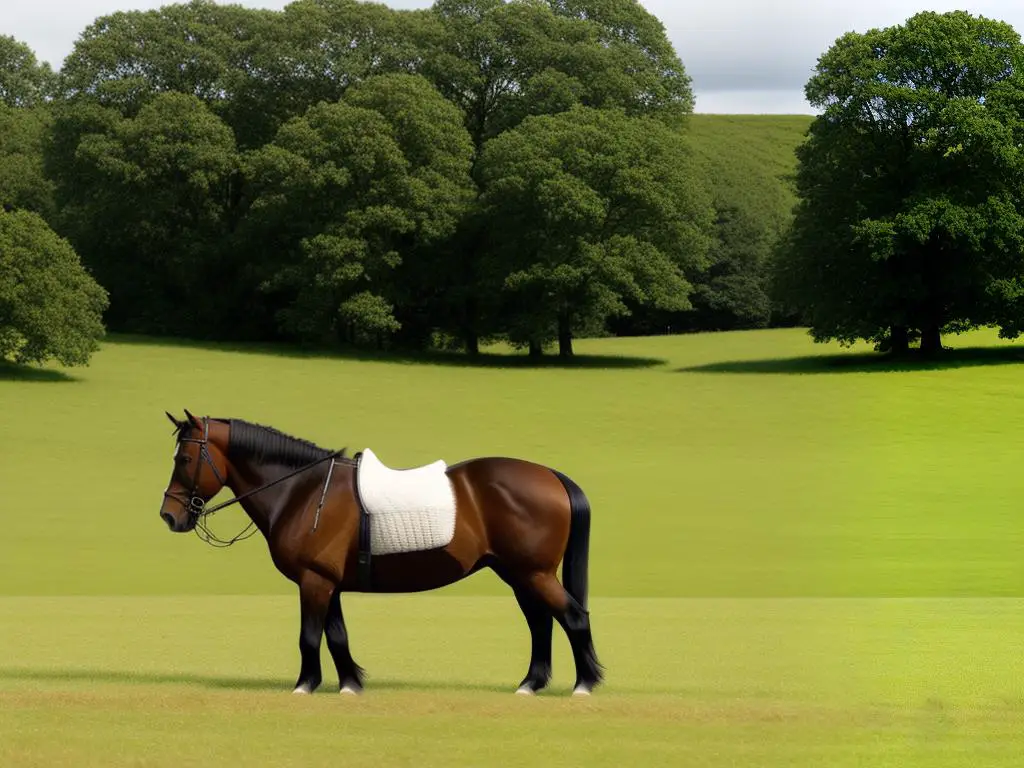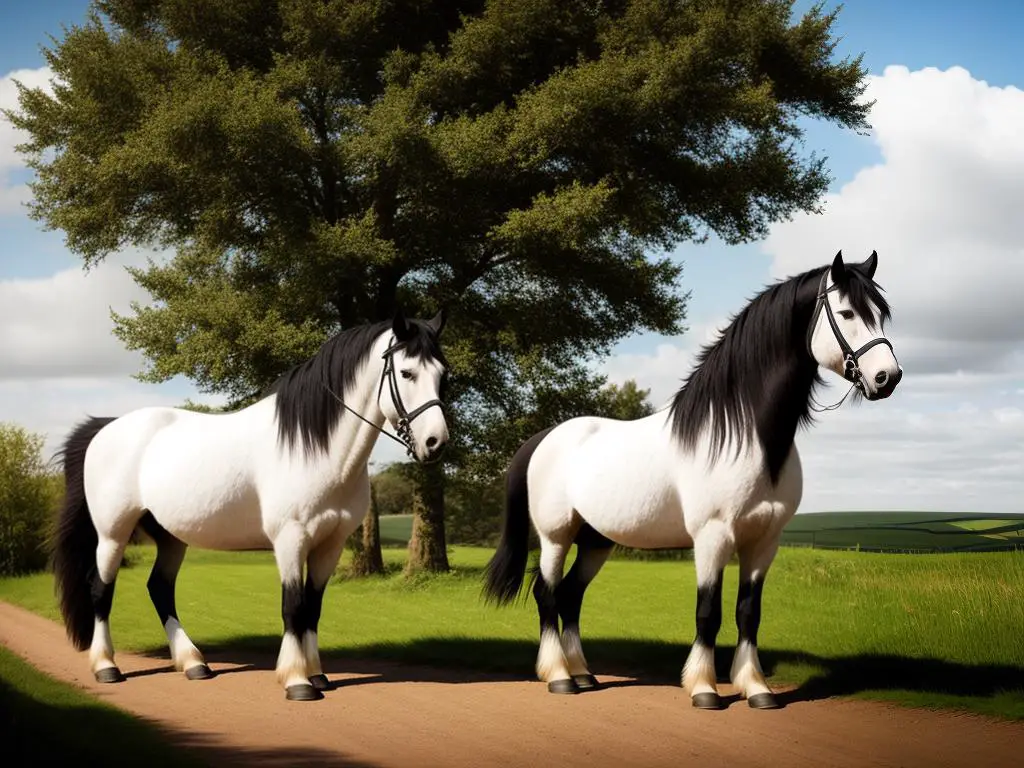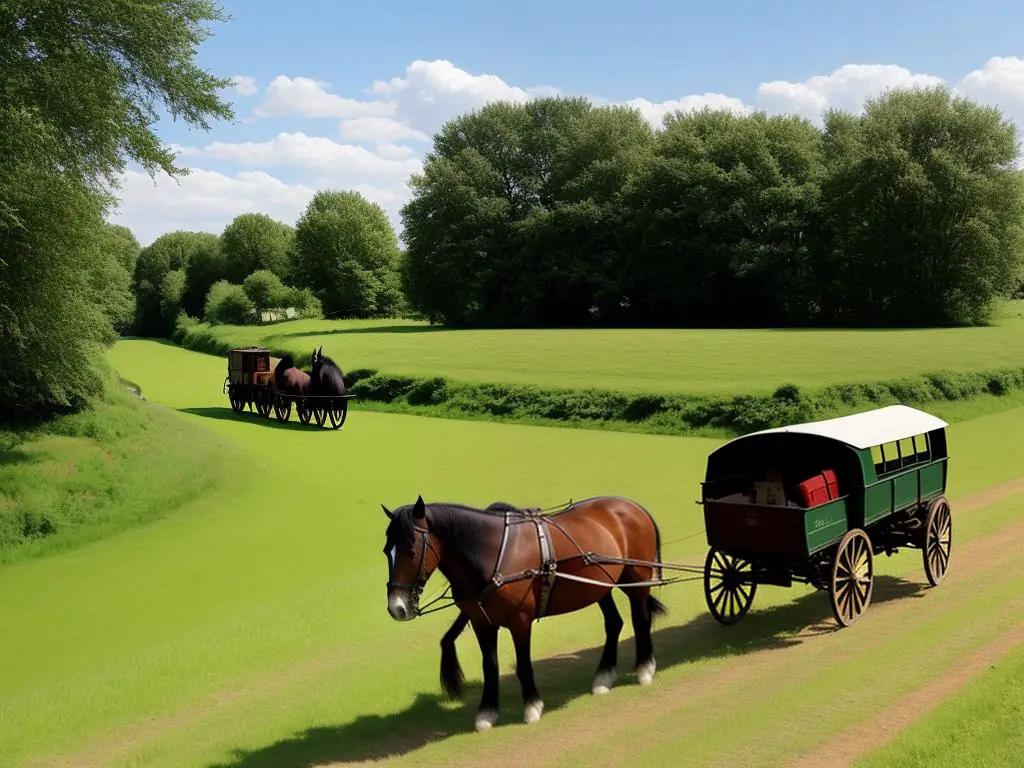The Shire horse, widely acclaimed and admired for its beauty, size, and strength, plays a key role in the historical and modern narrative of horse breeds globally. Majestic and awe-inspiring, these dignified creatures are not only the largest horse breed but also teem with a fascinating history, distinguished features, and impressive stature. This coverage delves into the intriguing world of Shire horses, exploring their genetic footprint, unique characteristics, distinct care needs, and versatile applications in various fields over the centuries.
Table of Contents (Horspedia)
History and Genetics of the Shire Horse
Origins and History of Shire Horses
The Shire horse is a breed of draught horse that originated in the United Kingdom. With roots dating back to the medieval ‘Great Horse,’ the Shire horse was traditionally used for farming and hauling heavy loads. This breed was developed by selecting the largest and strongest horses for breeding, which over time led to the large and powerful Shire we know today. The first Shire horse studbook was established by the Shire Horse Society of England in 1878, illustrating a more formal approach to their breeding and preservation. Additionally, Shire horses played a paramount role in both World War I and World War II, serving as artillery horses due to their strength and resilience.
Genetic Factors Behind Their Large Size
The large size and stature of the Shire horse are in large part due to selective breeding. They have been selectively bred for size and strength over centuries, making the Shire horse the largest breed of horse today. The average Shire horse stands between 17 and 19 hands high (a hand equates to approximately 4 inches), with males being able to reach up to 21.2 hands high. The most significant horses often weigh over a tonne. They have broad, muscular bodies and a comparably large head, supported by a powerful neck.
Genetics also plays a significant role in the appearance and distinct features of Shire horses. The breed is known for its bay, black, brown, and grey coat colors, and excessive feathering (long hair) on their lower legs, a trait shared with other draught breeds. Aesthetic traits, such as the long mane and feathered legs, have been continually selected for in the breeding process.
The Shire Horse Today
The advent of mechanized farming methods in the mid-20th century led to a precipitous decline in the population of Shire horses. However, efforts by breed enthusiasts and organizations have contributed to their resurgence in recent years. Today, the Shire horse is predominantly seen in exhibition and competition, rather than its historical farm and war roles. Overall, there is an increased demand for Shire horses in heavy horse shows, parades, and as ambassadors for draught horse breeds in public appearances.
Marveling at the Magnitude of the Shire Horse
Despite the potential health challenges connected to their immense size, such as a potential increased risk for certain forms of colic and limb injuries, the Shire horse holds a special place in the hearts of many due to its great strength, impressive endurance, and notably docile nature. A rising wave of interest in these gentle giants’ historical significance among horse enthusiasts and the general public alike has led to broader recognition and stepped-up conservation efforts for the largest breed of horse in existence – the Shire horse.

Characteristics and Care of the Shire Horse
A Glimpse into the Shire Horse’s Characteristics
The Shire horse breed stands as a symbol of majestic grandeur, awe-inspiring strength, and tranquil temperament. These horses, bred for labor, rank among the tallest in the world, generally measuring 16.2 to 17.2 hands (around 5.5 to 6 feet) tall at the withers, though certain individuals have extraordinary heights recorded at 21 hands (approximately 7 feet). These powerful, muscular creatures have broad backs, long legs with a unique “feathering” around the ankles, and come in multiple colors like black, bay, and grey, though black is most typically associated with the breed.
Contrary to what their towering stature might imply, Shire horses are renowned for their calming, gentle disposition. Their loyalty, intelligence, and tranquil demeanor makes them versatile, suited to a range of roles – from farm and forestry tasks to riding and carriage driving.
A well-cared-for Shire horse generally boasts a lifespan of 25 to 30 years, though various factors including genetics, diet, and veterinary care can affect this.
Care and Maintenance of the Shire Horse
Caring for a Shire horse requires special attention and resources due to their size and dietary needs. Feeding a Shire horse involves a careful balance of carbohydrates, proteins, and forage, with larger horses routinely consuming up to 60 pounds of hay per day. It is important to maintain a regular feeding schedule, providing water and salt blocks for hydration and mineral balance.
Grooming is critical for maintaining the Shire horse’s health and presentation. Their thick coat requires regular brushing to prevent matting and discomfort, while their distinctive “feathering” should be carefully checked and cleaned to prevent potential health issues. Shire horses’ hooves also require consistent care and trimming due to their size and the physical demands placed on them.
Health Challenges of Shires
Renowned for their strength and sturdiness, Shire horses are nonetheless susceptible to multiple health complications. One key concern is chronic progressive lymphedema, an affliction that provokes continuous swelling in the limbs as a result of their massive size. They can also face laminitis, a severe hoof inflammation condition.
A disease that specifically targets large breeds like Shires is Equine Polysaccharide Storage Myopathy (EPSM). EPSM is a metabolic muscle malady leading to muscle feebleness, rigidity, among other issues.
In addition, the colossal size and slow metabolism of Shire horses may make them vulnerable to obesity if their diet and exercise routines are not adequately supervised. It is thus essential to collaborate closely with an experienced equine veterinarian who can preemptively detect potential health issues and offer suitable interventions.

Shire Horses in Work and Show
The Historical Role of Shire Horses
Shire horses, known as one of the biggest horse breeds globally, boast a fascinating history that dates back to the medieval era. Originating as warhorses, they were the warriors’ choice, capable of enduring heavy armor and tough conditions. As the warfare age terminated, Shires pivoted towards roles in agriculture and industry, toiling in fields, hauling wagons, and facilitating goods transportation. In the United States, during the country’s infancy, Shire horses played a pivotal part in infrastructure development, such as canal construction and city planning.
Shire Horses in Agriculture and Industry
The advent of the Industrial Revolution in the 18th and 19th centuries saw a dramatic increase in the demand for Shire horses. Their sheer size and strength made them vital to agriculture and industry. They were used to pull heavy machinery and wagons, thereby playing an instrumental role in farming and transportation. They were also widely used in breweries to haul large drays filled with barrels of beer. Despite technological advancements, Shire horses remained prevalent in these industries until the mid 20th century.
Shire Horses: The Show Stopper
The significance of Shire horses is not limited to work alone. Owing to their stature and elegance, they have been prominent in horse shows and performances. Their impressive appearance coupled with their calm and gentle nature makes them stand out in the crowd. Shire horses have been successful in a variety of competitions from horse pulling contests to dressage. Today, they are a highlight of county fairs, parades, and breed-specific competitions.
Shire Horses in Popular Culture
Over time, Shire horses have permeated popular culture, seen in movies, literature and even beer advertisements. They are often chosen to portray a grand or magical image due to their size and majesty. For example, in The Lord of The Rings, several Shire horses were used to depict the magnificent steeds of the Middle-Earth. They continue to be popular in modern fantasy literature and film due to their connection with a bygone era.
Conservation and Relevance Today
Despite the reduction in their working roles in modern times, efforts have been undertaken to conserve this magnificent breed. Organizations like The Shire Horse Society and American Shire Horse Association are not only working towards preserving the breed but also promoting its versatility and relevance in today’s world. They have successfully introduced Shire horses to newer fields like therapeutic riding programs demonstrating the breed’s adaptability and resilience.
The Shire Horse’s Enduring Legacy
The Shire horse breed, with its captivating history and unique characteristics, has made notable contributions across different periods of human history. Despite their diminishing role in modern agriculture and industry, their presence in shows, performances, and popular culture is proof of their enduring legacy.

The Shire horse is a breed that commands acclaim and admiration for its contribution to the unfolding narrative of humanity’s partnership with horses. From the medieval battlefields to modern horse shows and agricultural lands, their distinct size, strength, and unyielding resilience have etched an indelible mark in various strata of society. Even more fascinating is their unapologetic grandeur, an aspect that continues to stir wonder and intrigue in equal measure. Indeed, the Shire horse, beyond its noteworthy physical traits and roles, stands as a riveting testament to the beauty of nature, the dynamic dance of genetics, and the value of proper care in achieving and maintaining true magnificity in the equine world.